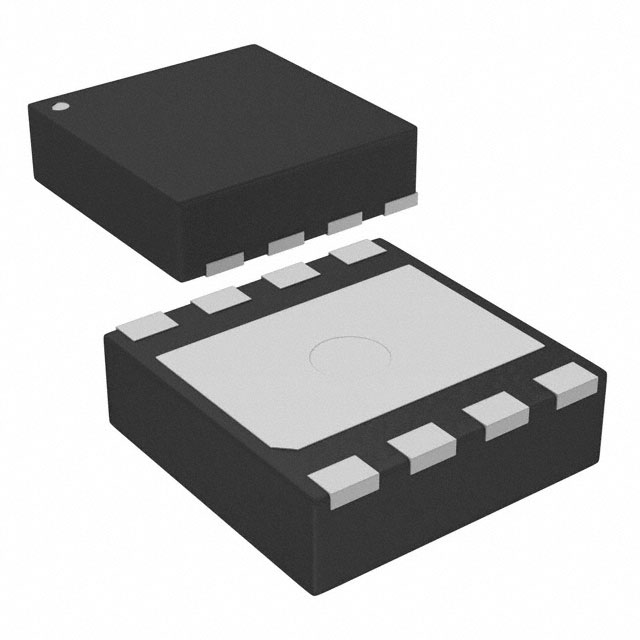TPS61060DRBR
Product Overview
Category
The TPS61060DRBR belongs to the category of integrated circuits (ICs) specifically designed for power management applications.
Use
This IC is commonly used to regulate and control power supply in various electronic devices, such as smartphones, tablets, portable media players, and other battery-powered devices.
Characteristics
- High efficiency voltage boost converter
- Wide input voltage range
- Adjustable output voltage
- Low quiescent current
- Over-temperature protection
- Short-circuit protection
Package
The TPS61060DRBR is available in a small outline package (SOIC) with an exposed pad. This package provides excellent thermal performance and ease of soldering.
Essence
The essence of the TPS61060DRBR lies in its ability to efficiently boost input voltage to a higher output voltage, making it suitable for battery-powered devices that require stable and regulated power supply.
Packaging/Quantity
The TPS61060DRBR is typically packaged in reels or tubes, containing a quantity of 2500 units per reel/tube.
Specifications
- Input Voltage Range: 1.8V to 6V
- Output Voltage Range: 2.5V to 5.5V
- Switching Frequency: Up to 1.2MHz
- Quiescent Current: 40µA (typical)
- Operating Temperature Range: -40°C to 85°C
Detailed Pin Configuration
The TPS61060DRBR has the following pin configuration:
- EN (Enable): Enable pin for turning the device on/off.
- FB (Feedback): Feedback pin for adjusting the output voltage.
- SW (Switch): Switch pin for controlling the internal power switch.
- GND (Ground): Ground reference for the IC.
- VIN (Input Voltage): Input voltage pin.
- VOUT (Output Voltage): Output voltage pin.
Functional Features
- High efficiency voltage boost conversion
- Adjustable output voltage through feedback pin
- Over-temperature protection for safe operation
- Short-circuit protection to prevent damage
- Low quiescent current for power-saving operation
Advantages and Disadvantages
Advantages
- Wide input voltage range allows compatibility with various power sources
- High efficiency conversion reduces power loss and extends battery life
- Adjustable output voltage provides flexibility for different device requirements
- Over-temperature and short-circuit protection enhance safety and reliability
- Low quiescent current minimizes power consumption during standby mode
Disadvantages
- Limited output voltage range may not be suitable for all applications
- Higher switching frequency may introduce electromagnetic interference in sensitive systems
Working Principles
The TPS61060DRBR operates as a voltage boost converter, utilizing an internal power switch to step up the input voltage to a higher output voltage. The control circuitry adjusts the duty cycle of the switch to regulate the output voltage based on the feedback received from the FB pin. This enables efficient power conversion while maintaining stability and accuracy.
Detailed Application Field Plans
The TPS61060DRBR finds extensive application in various battery-powered devices, including but not limited to: - Smartphones and tablets - Portable media players - Handheld gaming consoles - Wireless communication devices - Wearable electronics - Digital cameras
Detailed and Complete Alternative Models
- TPS61061DRBR: Similar to TPS61060DRBR, but with a higher output voltage range.
- TPS61062DRBR: Similar to TPS61060DRBR, but with a lower input voltage range.
- TPS61063DRBR: Similar to TPS61060DRBR, but with additional features like adjustable current limit and soft start.
These alternative models provide options for different voltage requirements, input ranges, and additional functionalities based on specific application needs.
In conclusion, the TPS61060DRBR is a highly efficient voltage boost converter IC used in various battery-powered devices. Its adjustable output voltage, wide input voltage range, and built-in protection features make it a versatile choice for power management applications.
Senaraikan 10 soalan dan jawapan biasa yang berkaitan dengan aplikasi TPS61060DRBR dalam penyelesaian teknikal
Sure! Here are 10 common questions and answers related to the application of TPS61060DRBR in technical solutions:
Q: What is TPS61060DRBR? A: TPS61060DRBR is a boost converter integrated circuit (IC) that provides a regulated output voltage from a lower input voltage.
Q: What is the input voltage range for TPS61060DRBR? A: The input voltage range for TPS61060DRBR is typically between 0.9V and 6V.
Q: What is the output voltage range for TPS61060DRBR? A: The output voltage range for TPS61060DRBR can be adjusted from 1.8V to 5.5V.
Q: What is the maximum output current of TPS61060DRBR? A: The maximum output current of TPS61060DRBR is 500mA.
Q: Can TPS61060DRBR operate with a single lithium-ion battery? A: Yes, TPS61060DRBR can efficiently boost the voltage from a single lithium-ion battery to power various applications.
Q: Does TPS61060DRBR have built-in protection features? A: Yes, TPS61060DRBR includes over-temperature protection, over-current protection, and under-voltage lockout to ensure safe operation.
Q: Can TPS61060DRBR be used in portable devices? A: Yes, TPS61060DRBR is commonly used in portable devices such as smartphones, tablets, and wearable devices to provide stable power supply.
Q: Is TPS61060DRBR suitable for low-power applications? A: Yes, TPS61060DRBR is designed for low-power applications and offers high efficiency even at light loads.
Q: Can TPS61060DRBR be used in automotive applications? A: Yes, TPS61060DRBR is suitable for automotive applications that require a regulated power supply with a wide input voltage range.
Q: What are the typical applications of TPS61060DRBR? A: TPS61060DRBR is commonly used in battery-powered devices, portable medical equipment, IoT devices, and other low-power electronic systems.
Please note that these answers are general and may vary depending on specific design requirements and application scenarios.


